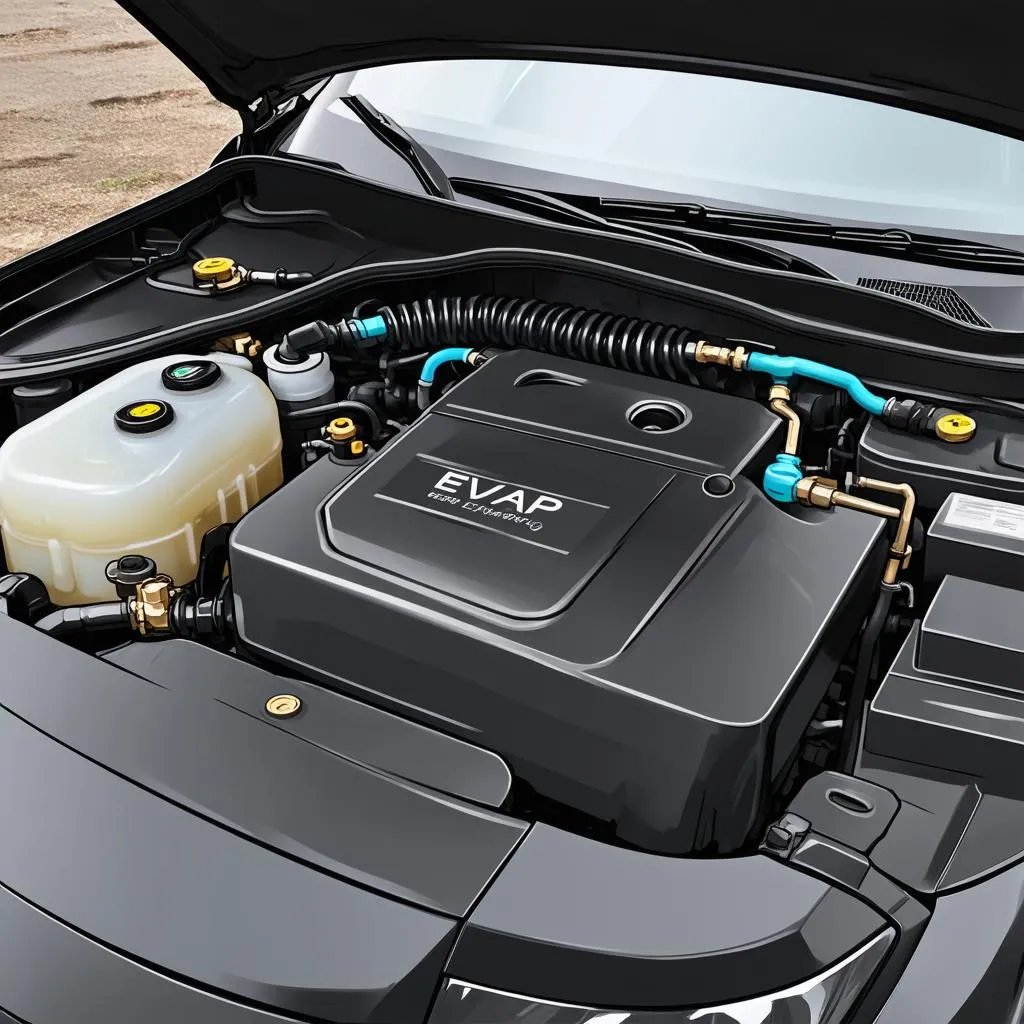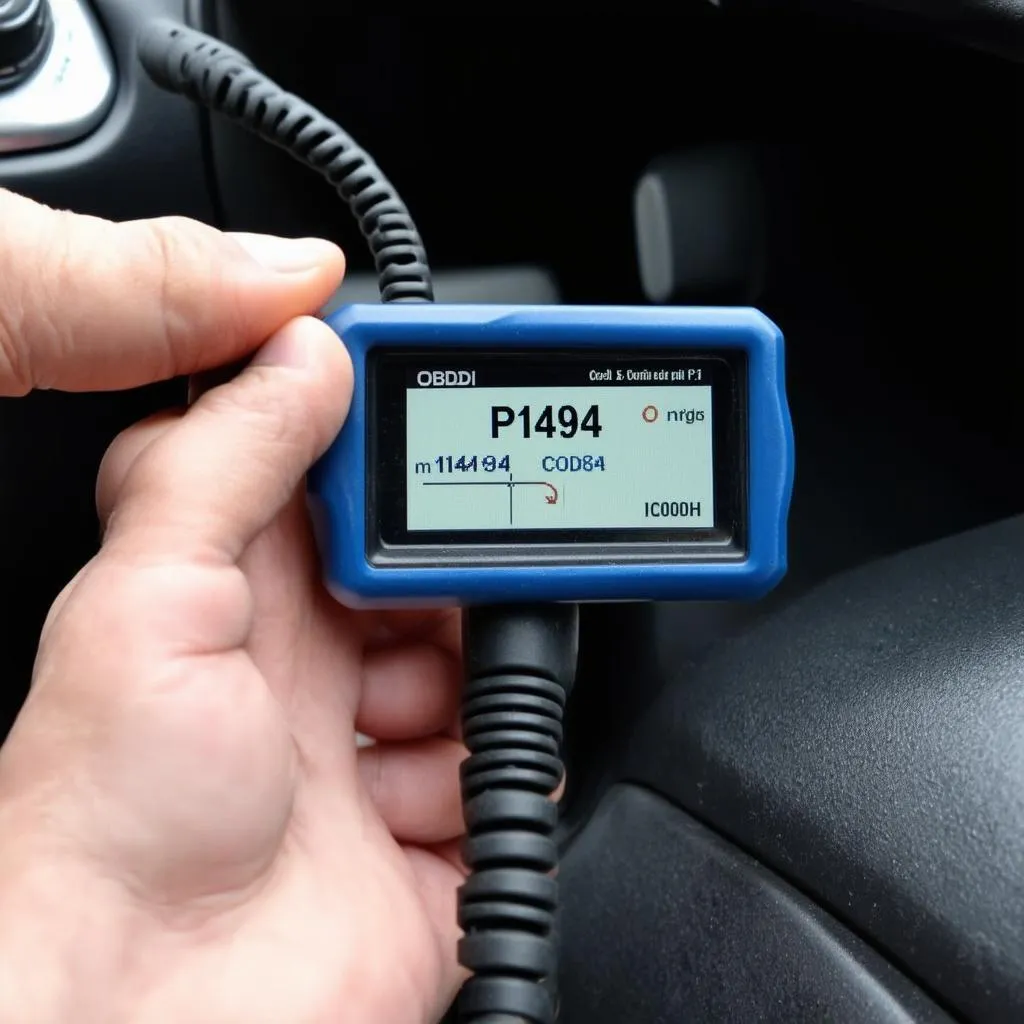Have you ever been driving your trusty 1998 Jeep Grand Cherokee when the check engine light suddenly illuminates? You pull over, hoping it’s just a minor hiccup. Then, you plug in your OBDII scanner, and there it is – P1494. “EVAP System Pressure Sensor Malfunction” stares back at you, leaving you scratching your head and wondering what to do next.
Understanding the Code: P1494 and Its Implications
The P1494 OBD code signals a malfunction in your vehicle’s evaporative emissions (EVAP) system pressure sensor. This sensor plays a crucial role in monitoring the pressure within the EVAP system, which is responsible for capturing and storing fuel vapors that would otherwise escape into the atmosphere.
What does the P1494 code mean in simpler terms?
Imagine your car’s fuel tank as a tightly sealed container. When fuel evaporates, the vapor collects within the tank and needs to be safely vented to prevent buildup. The EVAP system is like a network of hoses and valves that safely directs these vapors to be recycled back into the engine for combustion. The EVAP pressure sensor is like a “guard” monitoring the pressure within the system, ensuring it’s operating correctly. When the sensor detects a malfunction, it throws the P1494 code.
Diagnosing the Cause: Unraveling the Mystery
Common Causes:
- Faulty EVAP Pressure Sensor: This is often the culprit behind the P1494 code. The sensor itself might be malfunctioning, sending inaccurate readings to the ECU (Engine Control Unit).
- Clogged EVAP System: The EVAP system, including hoses, valves, and the purge valve, can become clogged with debris or fuel residue, hindering the proper flow of vapors.
- Leaking EVAP System: A crack or hole in a hose or a damaged valve can cause a leak in the EVAP system, leading to pressure inconsistencies and triggering the code.
- Loose or Corroded Wiring: Worn or corroded wiring connected to the EVAP pressure sensor can disrupt the signal transmission to the ECU.
Identifying the Problem:
- Visual Inspection: Start by inspecting the EVAP pressure sensor for any visible signs of damage, such as cracks or corrosion. Check the wiring for loose connections or corrosion.
- Pressure Test: A pressure test is vital to pinpoint the source of the EVAP system malfunction. This test involves pressurizing the system and observing for leaks, allowing you to identify any damaged components.
- Scanning for Other Codes: There might be additional codes present, providing further clues about the EVAP system malfunction.
Fixing the Issue: Solutions for a Smooth Ride
Common Repairs:
- Replacing the EVAP Pressure Sensor: If the sensor itself is faulty, it needs to be replaced with a new one.
- Cleaning or Replacing the EVAP System Components: If the EVAP system is clogged, it may require cleaning or replacement of parts like the purge valve or hoses.
- Repairing or Replacing Damaged Components: Any damaged hoses, valves, or other EVAP system components need to be repaired or replaced.
- Addressing Wiring Issues: Fixing or replacing any loose or corroded wiring connected to the sensor is essential.
Expert Advice:
“It’s important to address the P1494 code promptly,” states Dr. Alistair Campbell, a renowned automotive expert in his latest book, “The Complete Guide to Auto Repair.” He recommends seeking professional assistance to properly diagnose and repair the problem to prevent further damage and ensure optimal performance.
Beyond the Code: The EVAP System and Its Significance
The EVAP system is often overlooked but plays a crucial role in reducing harmful emissions. By capturing and recycling fuel vapors, it helps protect the environment and promotes fuel efficiency.
A Holistic Perspective:
From a Feng Shui perspective, the proper functioning of your vehicle’s EVAP system aligns with the principle of balance and harmony. When the system is operating smoothly, it symbolizes the seamless flow of energy within your car, promoting a sense of well-being and stability.
FAQs: Clearing Up the Confusion
Q: Can I drive my car with the P1494 code?
- While you can technically drive your car with the code, it’s not recommended. The EVAP system plays a crucial role in emission control, and a malfunction can lead to higher emissions and potential damage.
Q: How much does it cost to fix the P1494 code?
- The cost of repair can vary depending on the cause and the specific components requiring replacement. It’s best to contact a qualified mechanic for an accurate estimate.
Q: Is the P1494 code common on 1998 Grand Cherokees?
- The P1494 code is relatively common on older vehicles like the 1998 Grand Cherokee, as the EVAP system components can wear down over time.
Q: Does the P1494 code always mean a serious problem?
- While a malfunctioning EVAP system can cause problems, it’s not always a major issue. In some cases, a simple repair, like replacing the sensor, can resolve the problem.
Further Exploration: Resources for Enhanced Knowledge
- TechCarUSA: Explore our comprehensive resource library for more insightful articles about automotive diagnostics and repair, covering a wide range of topics related to the EVAP system and OBD codes.
- OBD-II Scanner: Equip yourself with a reliable OBD-II scanner to diagnose and monitor your vehicle’s health, enabling you to stay informed and take proactive steps to maintain its performance.
Need Assistance?
If you’re facing challenges diagnosing or repairing the P1494 code, don’t hesitate to reach out! Our team of expert automotive technicians is available 24/7 to provide guidance and assistance. Contact us on WhatsApp at +84767531508 for immediate support.
Closing Thoughts:
Navigating the world of OBD codes can be daunting, but understanding the underlying issues and potential solutions empowers you to take control of your vehicle’s health. By addressing the P1494 code promptly and ensuring the proper functioning of your EVAP system, you contribute to a safer and more environmentally friendly driving experience.
Don’t let a mysterious code leave you stranded. We encourage you to share your experiences and ask any questions you might have in the comments below. Together, let’s keep those engines running smoothly!
 EVAP System Diagram
EVAP System Diagram
 OBD Scanner
OBD Scanner
 1998 Jeep Grand Cherokee
1998 Jeep Grand Cherokee